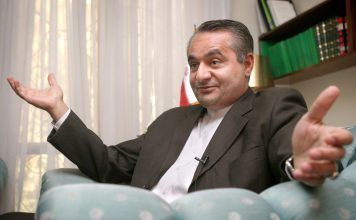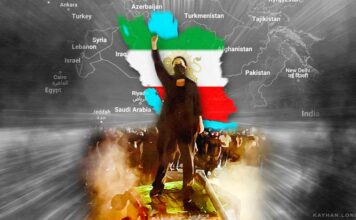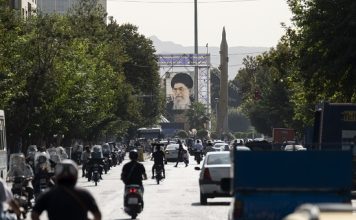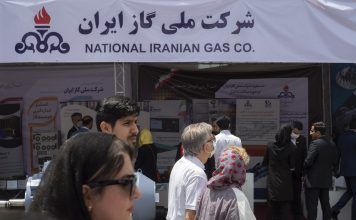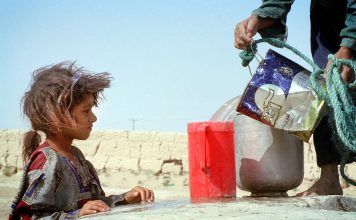By Potkin Azarmehr
It all started six years ago, with a few pictures showing off his massive bulk on Instagram. The photos quickly went viral, and Sajad Gharibi, born in 1991 in Iran’s oil-rich province of Khuzestan, started gathering attention and followers who were awestruck by his sheer size.
 The first three photos he posted were just what you would expect from a wannabe influencer drawing attention to his massive physical proportions. They were quickly followed by more pictures and descriptions in which he pledged his loyalty to the regime in Iran, wrapping himself with the flag of the Islamic Republic and declaring his desire to “defend the holy Shia shrines” in Syria under the command of his hero and idol, General Qasem Soleimani.
The first three photos he posted were just what you would expect from a wannabe influencer drawing attention to his massive physical proportions. They were quickly followed by more pictures and descriptions in which he pledged his loyalty to the regime in Iran, wrapping himself with the flag of the Islamic Republic and declaring his desire to “defend the holy Shia shrines” in Syria under the command of his hero and idol, General Qasem Soleimani.
Such declarations won him the regime’s approval, and he was seen as a poster child for the strength and might of the regime. Regime supporters praised him with comments on his Instagram posts, admiring his devotion. “You are the pride of our revolution” was a typical comment.
A news site in Iran affiliated with the Revolutionary Guards ran the headline praising him as a hero who sent fear into the heart of the enemy. He went on State TV local channels and this was rapidly followed by international fame.
[aesop_image img=”https://kayhanlife.com/wp-content/uploads/2022/08/Iranian-Hulk1.jpg” panorama=”off” credit=”KL./” align=”center” lightbox=”off” captionsrc=”custom” captionposition=”left” revealfx=”off” overlay_revealfx=”off”]
The Sun newspaper and other publications around the world ran stories about him with his pictures, and he became known as the “Iranian Hulk” or the “Persian Hercules”. His Instagram followers reached one million. His posts were both in English and in Persian.
More fame was followed by offers of sponsorship and movie parts, but also with skepticism and scrutiny. Was he really that huge or were the pictures edited?
[aesop_image img=”https://kayhanlife.com/wp-content/uploads/2022/08/Iranian-Hulk54.jpg” panorama=”off” credit=”KL./” align=”center” lightbox=”off” captionsrc=”custom” captionposition=”left” revealfx=”off” overlay_revealfx=”off”]
On Oct.19, 2021, he posted: “Haters gonna say it’s photoshop this is real life hulk, not fake Hollywood pretty boy @martynfordofficial”.
His first boxing debut with Martyn Ford was initially scheduled for April 30 at the O2 Arena in London. Sajad’s fame and fortune started taking a dive when in the pre-fight face-off with Ford, he collapsed to the ground with a slight push by Ford, and it became clear that he was nothing like his Instagram pictures suggested. The incident was so humiliating and embarrassing that the fight was cancelled.
David Feldman, the promotion’s president, said that the fight had been cancelled because there were concerns the so-called “Persian Hercules” hadn’t been truthful in his photos.
Another fight was arranged in Dubai with a different opponent, the Kazakh Titan, whose real name is Djumanov Almat Bakhytovich. Despite his stage name, the Kazakh Titan is in actual fact a mediocre boxer with no impressive record to show.
Sajad tried to wipe out the embarrassing face-off with Ford by getting back to his usual cyber saber-rattling, telling the Kazakh, “Tomorrow night u have no body guard in the ring I will eat you”.
A eulogist reciting Shia lyrics of heroism and devotion preceded Sajad’s entrance into the ring. It served only to weigh heavier on the humiliation that was to come.
If the faceoff with Ford was embarrassing, the fight with the Kazakh Titan was mortifying and shameful. The “Persian Hercules” was more like what Iranians refer to as a ‘cotton champion,’ an expression used in Persian to describe a fake hero or a paper tiger.
Sajad could not throw a decent punch. He fought like a drunk man in a pub brawl. It looked like he had never been in a fight. All the time, he was turning and running away, hoping the ordeal would end as soon as possible. He just wanted to quit, take the money and run. The much hyped fight was stopped in less than two minutes.
“I have nothing to say but I am ashamed and I apologize to the Iranian people,” Sajad said in an attempt to win sympathy, but the fury of Iranians against him was unstoppable.
Sajad’s boasting social media posts — in which he vowed to “eat” the Kazakh Titan — were met with mockery and insults, and descriptions of him as a ‘cotton champion.’
The comments read as follows:
“The Shia eulogist lasted longer than you.”
“You could have at least bit him so we could say you hurt him.”
“Thank God, you didn’t go to Syria!”
“It was the best comedy show ever. Thanks for all the laughs.”
“You hit the referee more times than you hit the Kazakh.”
More than 100,000 comments were posted, heightening the indignity that the boxer was already suffering.
Even Sajad’s coach had to limit the damage to his own credibility by saying that he had only had two weeks to train Sajad and had told him that he was not ready.
Sajad’s fate is emblematic of the Islamic Republic today — a paper tiger avowing “hard revenge” and not following through; a bully that cowers every time someone stands up to him; a regime that appears outwardly powerful, but is, in truth, weak and incompetent.


